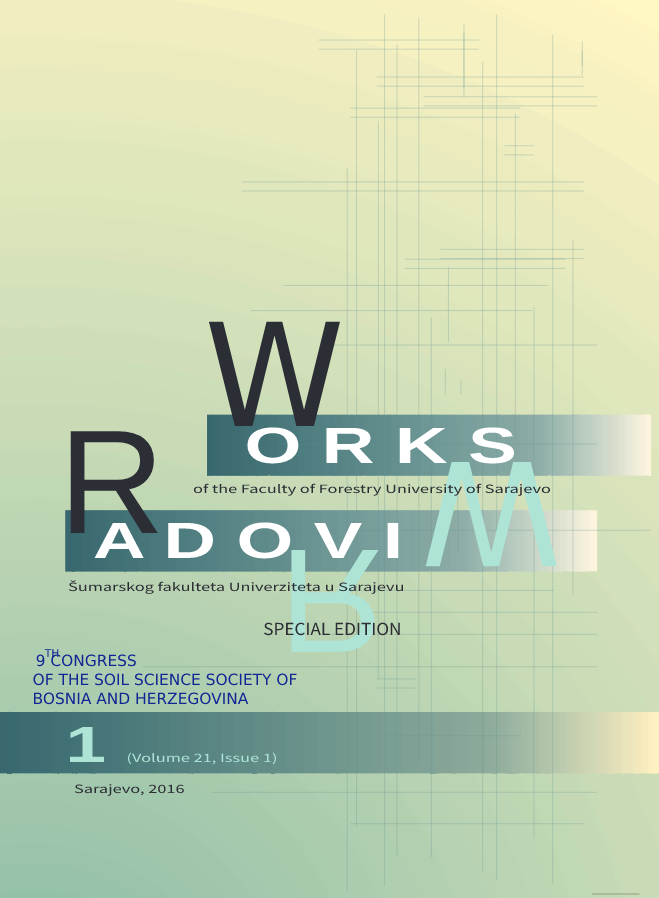SOILS PROPERTIES AND CARBON CONTENT AT RESEARCH OBJECTS IN FIR-BEECH FORESTS ON CALCAREOUS BEDROCKS OF THE DINARIC MOUNTAIN CHAIN: A CASE STUDY FROM SLOVENIA AND BOSNIA
DOI:
https://doi.org/10.54652/rsf.2016.v1.i1.288Ključne riječi:
forest management, organic matter, calcareous bedrocks, C stocksSažetak
UDK 630*114:630*242(497.6)
Large areas of European fir-beech forests are characteristic for the Dinaric Mountains and represent one of the most important forest ecosystems in the region. Such forests extend in high karst plateaus from the eastern Alps in SE Slovenia to the N Albanian massifs at the altitudes from 700 to 1200 (1500) m a.s.l. This is the area with a diverse landscape configuration. The bedrock is consisted of limestone, occasionally of dolomite limestone and dolomite. There are various soil conditions, where in a small area, a mosaic of Leptosols, Rendzic Leptosols, Chromic Cambisol, Calcaric and Chromic Luvisols occur. As climate conditions are very favourable for the growth of forests (high precipitation and air humidity), production function of wood is much more emphasized. Very little is known about the long-term effects of forest management and intensity of logging on soil organic matter quality and carbon stocks in these forest soils. Therefore, with an objective to understand better variations in soil properties, both in space and time, aiming to minimize the uncertainties of the SOC (soil organic carbon) and TN (total nitrogen) stocks, we have set up a research objects in silver fir-beech forests, in Slovenia (research plots in Kočevje, Snežnik and Trnovo) and Bosnia and Herzegovina (research plots on MT Bjelašnica). We analysed soil properties of the unmanaged and managed sites studying differences between treatments and also changes for the two years period of observations. Preliminary results from Slovenian sites show that the high intensity of logging (50 and 100% cut of growing stock) causes a decrease in SOC and TN contents, wider C/N ratio and higher pH values, with the largest level of alternations in the organic part of the soils. The study in Bosnia gave information on inherent SOC and TN concentrations in the organic and surface mineral soil, and also indicated no differences in soil properties between unmanaged and managed sites characterized by low (14-18%) intensities of logging.
Downloads
References
Baritz, R., Seufert, G., Montanarella, L., Van Ranst, E., 2010. Carbon concentrations and stocks in forest soils of Europe. For. Eco. Manag. 260: 262-277.
Bauhus, J., Vor, T., Bartsch, N., Cowling, A., 2004. The effects of gaps and liming on forest floor decomposition and soil C and N dynamics in a Fagus sylvatica forest. Can. J. For. Res. 34, 509–518.
Christophel, D., Spengler, S., Schmidt, B., Ewald, J., Prietzel, J., 2013. Customary selective harvesting has considerably decreased organic carbon and nitrogen stocks in forest soils of the Bavarian Limestone Alps. For. Eco. Manag. 305: 167–176.
Ćirić, M., Stefanović, M., Drinić, P., 1971. Tipovi bukovih šuma i mješovitih šuma bukve, jele i smrče u Busni i Hercegovini. Šumarski fakultet i institut za šumarstvo u Sarajevu. Posebna izdanja br. 8.
Cools, N., De Vos, B., 2010. Sampling and Analysis of Soil. Manual Part X, 208 pp. In: Manual on methods and criteria for harmonized sampling, assessment, monitoring and analysis of the effects of air pollution on forests, UNECE, ICP Forests, Hamburg. ISBN: 978-3-926301-03-1.[http://www.icp-forests.org/Manual.htm]
Currie, W.S., 1999. The responsive C and N biogeochemistry of the temperate forest floor. Trends in Ecology & Evolution 14, 316–320.
Ellert, B.H., Janzen, H.H., Entz, T., 2002. Assessment of a method to measure temporal change in soil carbon storage. Soil Sci. Soc. Am. J. 66, 1687–1695.
Homann, P.S., Bormann, B.T., Boyle, J.R., Darbyshire, R.L., Bigley, R. 2008. Soil C and N minimum detectable changes and treatment differences in a multi-treatment forest experiment. For. Eco. Manag. 255 1724–1734.
IUSS Working Group WRB, 2015. World Reference Base for Soil Resources 2014, update 2015, International soil classification system for naming soils and creating legends for soil maps. World Soil Resources Reports No. 106. FAO, Rome.
Johnson, C.E., Johnson, A.H., Huntington, T.G., 1990. Sample size requirements for the determination of changes in soil nutrient pools. Soil Sci. 150, 637–644.
Johnson, D.W., Curtis, P.S., 2001. Effects of forest management on soil C and N storage: meta-analysis. For. Eco. Manag. 140, 227–238.
Jurgensen, M., Tarpey, R., Pickens, J., Kolka, R., Palik, B., 2012. Long-term effect of silvicultural thinnings on soil carbon and nitrogen pools. Soil Sci. Soc. Am. J. 76, 1418–1425.
Kutnar, L., Eler, K., Marinšek, A., 2015. Effects of different silvicultural measures on plant diversity - the case of the Illyrian Fagus sylvatica habitat type (Natura 2000). Journal of Biogeosciences and Forestry published by SISEF.
Kutnar, L., Matijašić, D., Pisek, R., 2011. Conservation status and potential threats to Natura 2000 forest habitats in Slovenia. Šumarski list 135 (5-6): 215-231.
Lal, R., 2005. Forest soils and carbon sequestration. For. Ecol. Manage. 230, 242–258.
Luyssaert, S., Hessenmoller, D., Von, Lupke, Kaiser, S, Schulze, E.D. 2011. Quantifing land use and disturbance intensity in forestry, based on the self-thining relationship. Ecol. Appl. 21:3272-3284.
Prescott, C. 2002. The influence of the forest canopy on nutrient cycling. Tree Physiology 22:1193-1200.
Prietzel, J., 2010. Schutzwälder der Nördlichen Kalkalpen. Verjüngung, Mikroklima, Schneedecke und Schalenwild Schweizerische Zeitschrift für Forstwesen 161, 12–22.
Puncer, I., 1979: Ekološke in floristične značilnosti združbe Abieti – Fagetumna Trnovskem gozdu. Proc. 2 Congr. Ekol. Jugosl., Zagreb 2, 925–938.
Puncer, I., 1980: Dinarski jelovobukovi gozdovina Kočevskem. Razprave 4. razr. SAZU 22, 401–546.
Schoenholtz, S.H., Van Miegroet, H., Burger, J.A., 2000. A review of chemical and physical properties as indicators of forest soil quality: challenges and opportunities. For. Eco. Manag.138: 335±356.
Schrumpf, M., Schulze, E.D., Kaiser, K., Schumacher, J., 2011. How accurately can soil organic carbon stocks and stock changes be quantified by soil inventories? Biogeosciences 8, 1193–1212.
Schulze, E.D., 2000. Carbon and Nitrogen Cycling in European Forest Ecosystems.
Berlin, Springer.
Stefanović, V., Beus, V., Burlica, Č., Dizdarević, H., Vukorep, I., 1983: Ekološko vegetacijska rejonizacija Bosne i Hercegovine. Posebna izdanja br. 17. Šumarski fakultet u Sarajevu. Sarajevo.
VonLützow, M., Kögel-Knabner, I., Ekschmitt, K., Matzner, E., Guggenberger, G., Marschner, B., Flessa, H., 2006. Stabilization of organic matter in temperate soils: mechanisms and their relevance under different soil conditions – a review. European Journal of Soil Science 57, 426–445.
Yanai, R.D., Stehman, S.V., Arthur, M.A., Prescott, C.E., Friedland, A.J., Siccama, T.G., Binkley, D., 2003. Detecting change in forest floor carbon. Soil Sci. Soc. Am. J. 67, 1583–1593.























